Did you know that a single frog can lay up to 4,000 eggs in one season? This incredible number is just the start of a fascinating journey. Frogs undergo a remarkable transformation, known as metamorphosis, which takes them through several distinct stages.
From tiny eggs to wiggling tadpoles, and eventually to hopping adults, each phase is a marvel of nature. This process is not only captivating but also plays a vital role in pond ecosystems. Spring is the perfect time to observe this phenomenon, as many species begin their spawning season.
For kids and science enthusiasts alike, understanding these stages offers a window into the wonders of biology. Plus, with printable worksheets available, learning about frogs has never been more fun. Dive in to explore the journey from egg to adult frog and discover why these creatures are so important to our environment.
Key Takeaways
- Frogs go through four main stages: egg, tadpole, froglet, and adult.
- Metamorphosis is the process that transforms a tadpole into a frog.
- Spring is the prime season for frog spawning in ponds.
- Frogs play a crucial role in maintaining healthy ecosystems.
- Printable resources make learning about frogs engaging for kids.
Introduction to the Life Cycle of Frogs
Amphibians like frogs have a unique dual existence in water and on land. Unlike mammals, which develop inside their mothers, frogs begin their journey as jelly-like eggs in water. This process, known as metamorphosis, transforms them from aquatic tadpoles to land-dwelling adults.
During winter, frogs hibernate in pond mud or log piles to survive the cold. When spring arrives, they emerge to lay their eggs in water. This seasonal timing ensures the eggs have the best chance of survival. The egg masses, often protected by a jelly-like coating, are an evolutionary advantage that safeguards the developing embryos.
For kids, learning about this process is both educational and fun. Printable worksheets, like those found on Nat Geo Kids, make it easy to explore the stages of frog development. These resources also highlight the importance of frogs in monitoring ecosystem health.
From egg to adult, the transformation takes about 14 weeks. Each stage, from tadpole to froglet, is a testament to nature’s ingenuity. By understanding this animal life cycle, we gain a deeper appreciation for the role frogs play in our environment.
What is the Life Cycle of a Frog?
The transformation of a frog is one of nature’s most fascinating processes. This life cycle involves five distinct stages, each crucial for the development of the frog. Understanding these stages helps us appreciate the complexity of animal life.
Frogs undergo complete metamorphosis, which means they experience dramatic changes in form and function. This is different from incomplete metamorphosis, seen in insects like grasshoppers, where the young resemble adults. The five stages of a frog’s development are:
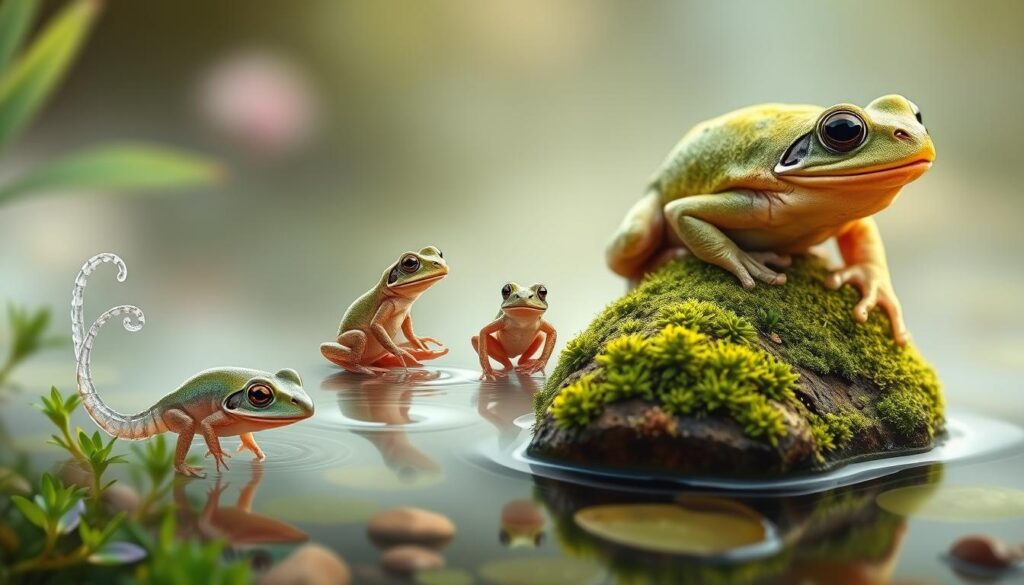
| Stage | Description |
|---|---|
| Egg | Laid in water, protected by a jelly-like coating. |
| Tadpole | Aquatic, with gills for breathing underwater. |
| Tadpole with Legs | Develops hind legs, begins to resemble a frog. |
| Froglet | Front legs emerge, tail starts to shrink. |
| Adult Frog | Fully developed, capable of living on land. |
The entire process takes about 12-16 weeks, depending on environmental conditions. However, frogs reach reproductive maturity only after 2-4 years. This means they must survive multiple cycles of growth and development before they can reproduce.
It’s important to note the difference between a froglet and a young frog. A froglet is still in the transitional phase, while a young frog is fully developed but not yet mature. Activities like worksheet sorting and photographic documentation are excellent ways to learn about these stages in detail.
For more in-depth information, allaboutfrogs.org is a trusted resource. The cyclical nature of this process ensures that frogs continue to thrive, playing a vital role in ecosystems worldwide.
Stage 1: The Egg
The journey of a frog begins with a delicate yet resilient egg. These eggs are often laid in calm freshwater habitats like ponds, where they float in jelly-like masses called frogspawn. This unique texture not only keeps the eggs buoyant but also protects them from predators and environmental hazards.
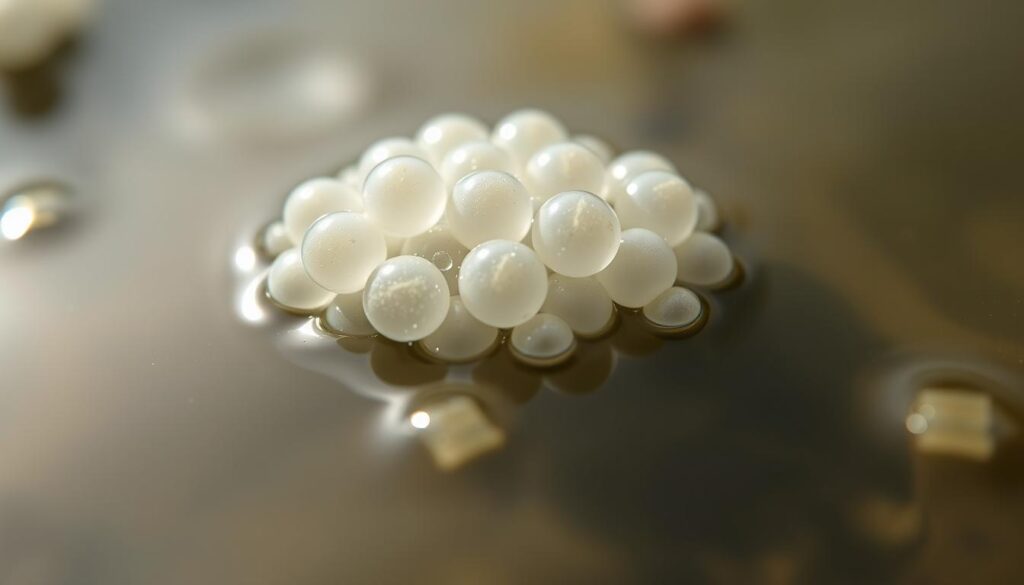
Frogs typically lay eggs during the spring, a time when conditions are ideal for development. Each mass can contain hundreds to thousands of eggs, ensuring a higher chance of survival despite threats like fish and insects. Unlike bird or reptile eggs, frog eggs lack a hard shell, relying instead on their gelatinous coating for protection.
Where Do Frogs Lay Their Eggs?
Frogs prefer to lay their eggs in calm, freshwater environments such as ponds, lakes, or slow-moving streams. These habitats provide the necessary warmth and nutrients for the eggs to develop. Proper pond maintenance, like ensuring clean water and minimal disturbances, can significantly improve egg survival rates.
How Many Eggs Do Frogs Lay?
The number of eggs a frog lays varies by species, but it can range from hundreds to thousands per mass. This high number compensates for the many eggs that may not survive due to predation or environmental factors. Temperature also plays a crucial role, as warmer waters accelerate development, while colder temperatures slow it down.
Stage 2: The Tadpole
After hatching, tadpoles emerge as tiny, fish-like creatures ready to explore their aquatic world. This stage is crucial for their development, as they grow and prepare for the next phase of their transformation. Tadpoles are fascinating to observe, especially for those interested in science and nature.
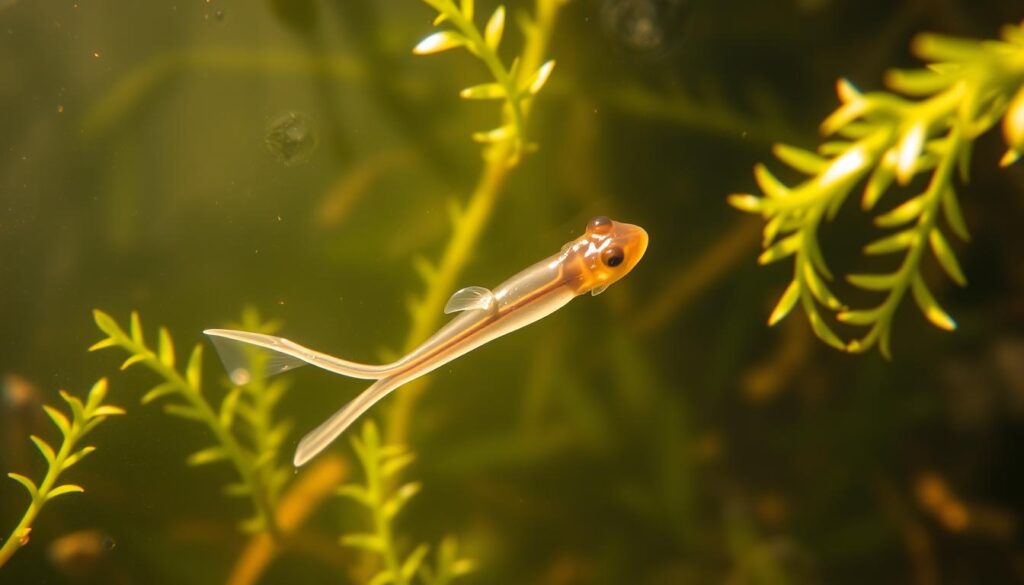
What Does a Tadpole Look Like?
Tadpoles resemble small fish with long tails and no legs. They have gills, which allow them to breathe underwater. Their tails are their primary means of propulsion, helping them swim efficiently in their watery environment. This fish-like appearance is temporary, as they gradually develop legs and lose their tails.
What Do Tadpoles Eat?
During this stage, tadpoles are herbivores, feeding mainly on algae and other small aquatic plants. Their diet is essential for their growth and energy needs. As they develop, their food preferences will change, but for now, they rely on plant matter to thrive.
“Tadpoles are a great example of nature’s adaptability, showcasing how organisms evolve to survive in their environments.”
For those observing tadpoles in a classroom or at home, it’s important to maintain clean water and ensure proper oxygen levels. Regular tank cleaning and monitoring are necessary to keep the tadpoles healthy. Comparing wild and captive habitats can also provide valuable insights into their behavior and needs.
| Aspect | Details |
|---|---|
| Appearance | Fish-like with tails and gills |
| Respiration | Gills for underwater breathing |
| Movement | Tail propulsion |
| Diet | Algae and aquatic plants |
For more detailed information on tadpole development, visit vitalfrog.com. Observing these creatures through a microscope or measuring their growth can be an engaging educational activity for kids and adults alike.
Stage 3: Tadpole with Legs
As tadpoles grow, they undergo a remarkable transformation that prepares them for life on land. This stage is marked by the development of legs, a critical step in their journey. The process begins with the appearance of hind legs, followed by front legs, signaling a shift in their anatomy and behavior.
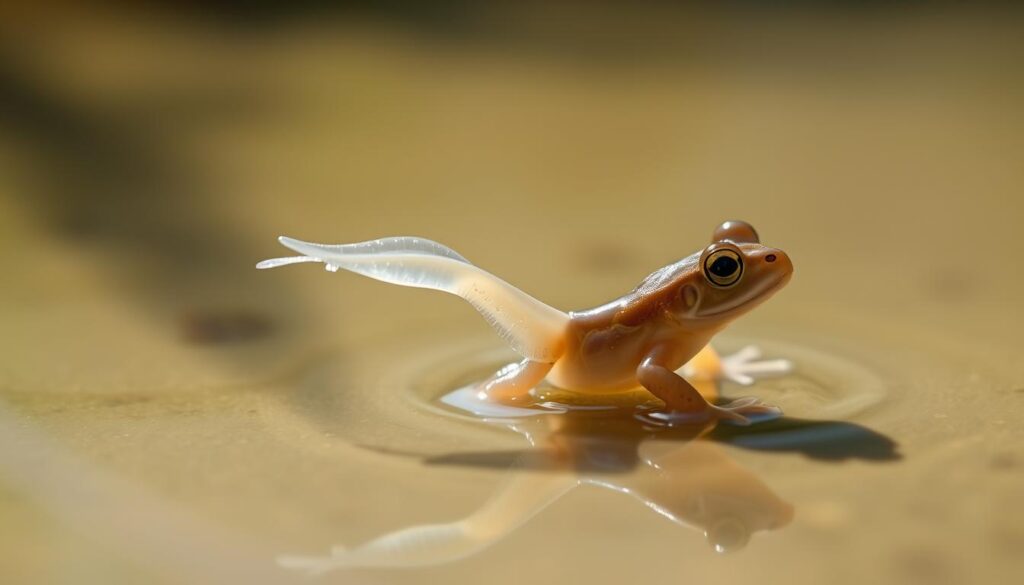
When Do Tadpoles Develop Legs?
Hind legs typically appear between 6 to 9 weeks, depending on environmental conditions. Front legs follow shortly after, completing the limb development. Calcium plays a vital role in bone growth during this time, ensuring the tadpoles’ skeletons are strong enough to support their new appendages.
How Do Tadpoles with Legs Behave?
With the emergence of legs, tadpoles begin to exhibit changes in behavior. They transition from swimming freely to spending more time at the bottom of the water. Their diet also shifts from herbivorous to omnivorous, incorporating insects and small organisms. This dietary change supports their increased energy needs.
However, this stage also introduces risks, such as cannibalism among tadpoles. To minimize this, maintaining proper tank depth and ensuring adequate food supply are essential. Observing these changes can be made easier with leg development tracking charts, a helpful tool for enthusiasts and educators alike.
“The transformation from tadpole to froglet is a testament to nature’s adaptability, showcasing how organisms evolve to thrive in changing environments.”
As their legs develop, tadpoles’ skin thickens, preparing them for life on land. Their oxygen needs also increase, requiring well-aerated water to support their growth. For more detailed insights into tadpole development, explore this comprehensive resource.
Stage 4: The Froglet
The froglet stage is a critical phase in the development of frogs. During this time, they transition from aquatic tadpoles to land-dwelling creatures. This stage is marked by significant changes in their anatomy and behavior, preparing them for life outside the water.
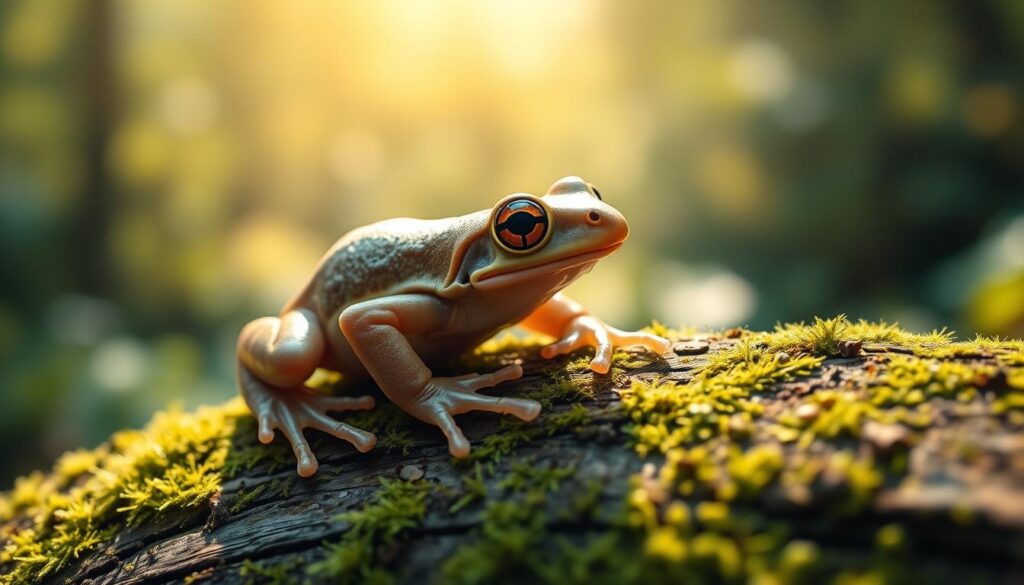
What is a Froglet?
A froglet is a young frog that has developed legs but still retains a small tail. This tail gradually disappears through a process called resorption, which typically completes by the 12th week. Froglets also develop fully functional lungs, allowing them to breathe air instead of relying on gills.
How Do Froglets Transition to Land?
As froglets prepare for life on land, their skin thickens to prevent dehydration. They also become more active at night, adopting nocturnal behavior patterns. To support this transition, their terrarium should mimic their natural habitat with proper humidity levels and hiding spots.
Froglets begin exploring land by taking short jumps, usually covering distances of up to 6 inches. However, they are still vulnerable to dehydration, so maintaining a moist environment is crucial. Gradually increasing their exposure to land helps them adapt safely.
| Aspect | Details |
|---|---|
| Tail Resorption | Completes by 12 weeks |
| Lung Development | Fully functional for air breathing |
| Skin Adaptation | Thickens to prevent dehydration |
| Behavior | Nocturnal, active at night |
| Jumping Distance | Up to 6 inches |
For those raising froglets, it’s important to monitor their progress and provide a balanced environment. Activities like measuring their growth and observing their behavior can be both educational and engaging.
Stage 5: The Adult Frog
The final stage of a frog’s development is both fascinating and essential for its survival. At this point, the frog has fully transitioned from its aquatic beginnings to a land-dwelling predator. This stage marks the completion of metamorphosis, where the frog is now equipped to thrive in its environment.
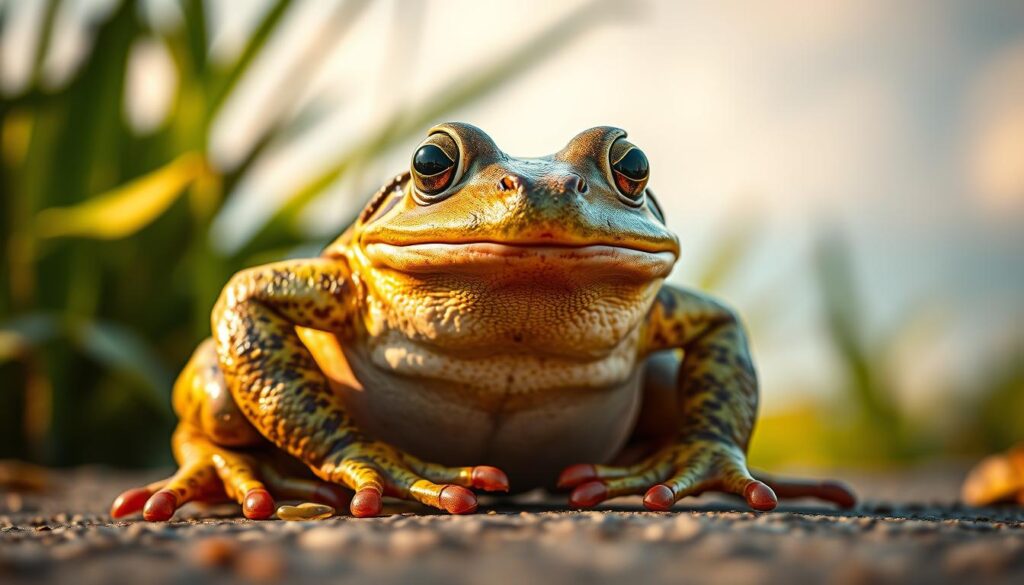
What Does an Adult Frog Look Like?
Adult frogs exhibit a wide range of colors and patterns, often blending seamlessly into their surroundings. Some species display bright hues to warn predators of their toxicity, while others rely on camouflage for protection. Sexual dimorphism is common, with males often sporting vocal sacs for mating calls and females being slightly larger.
Their bodies are streamlined for jumping, with powerful hind legs and webbed feet. The skin of an adult frog is smooth and moist, aiding in respiration and hydration. These adaptations make them highly efficient in both aquatic and terrestrial environments.
What Do Adult Frogs Eat?
Adult frogs are carnivorous, feeding primarily on insects like flies, mosquitoes, and beetles. Their sticky, projectile tongues are perfectly designed for catching prey in a fraction of a second. Seasonal variations in their diet occur, with some species consuming larger prey, such as small fish or even other frogs.
“The feeding habits of adult frogs are a testament to their role as natural pest controllers, helping to keep insect populations in check.”
For those interested in observing these behaviors, setting up a bug-catching activity can be both educational and entertaining. However, it’s important to avoid areas treated with pesticides, as these chemicals can harm frogs and disrupt their ecosystems.
Adult frogs typically reach full maturity between 2 to 4 years, depending on the species. Their lifespan varies, with some living up to 10 years or more in the wild. By understanding their development and behavior, we can better appreciate the vital role they play in maintaining balanced ecosystems.
The Role of Metamorphosis in the Life Cycle of Frogs
Metamorphosis is a biological marvel that reshapes frogs from aquatic tadpoles to terrestrial adults. This process involves dramatic changes in anatomy, physiology, and behavior, driven by hormonal triggers like the thyroid hormone. It’s a key example of how animals adapt to their environments.
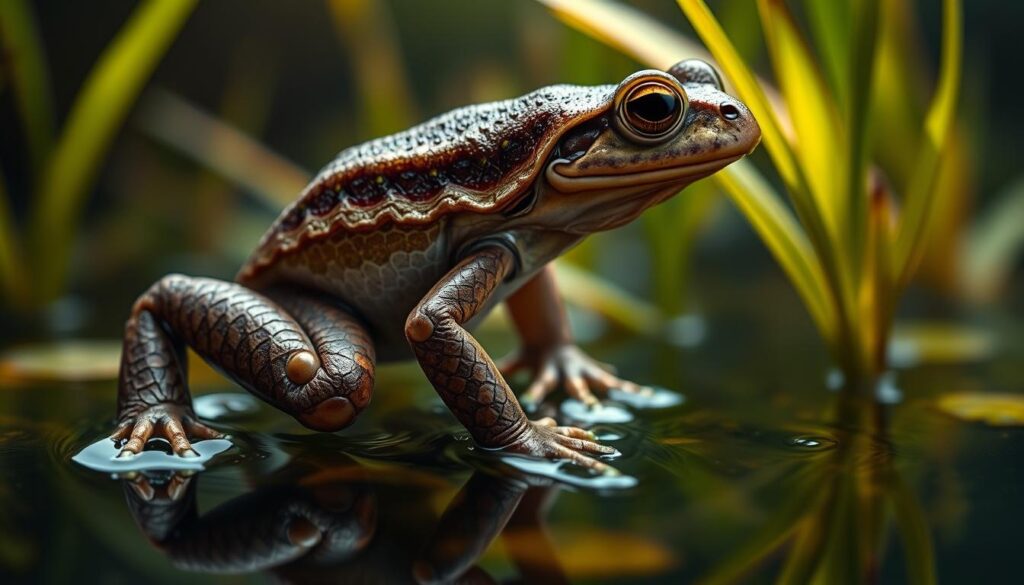
Unlike incomplete metamorphosis seen in insects like grasshoppers, frogs undergo complete metamorphosis. This means they experience a total transformation, from gill-breathing tadpoles to lung-equipped adults. The thyroid hormone plays a critical role in regulating these changes, ensuring each stage transitions smoothly.
Comparing frog metamorphosis to butterfly metamorphosis reveals fascinating parallels. Both involve distinct stages and significant biological changes. However, frogs transition from water to land, while butterflies remain terrestrial. This highlights the versatility of development in nature.
Metamorphosis offers evolutionary advantages. It allows frogs to exploit different ecological niches, reducing competition for resources. This adaptability is a marvel of biological engineering, showcasing nature’s ingenuity.
“Metamorphosis is not just a change in form but a complete overhaul of a frog’s biology, enabling it to thrive in diverse environments.”
Temperature plays a crucial role in this process. Warmer environments accelerate metamorphosis, while cooler temperatures slow it down. This sensitivity makes frogs excellent indicators of environmental health, as changes in their life cycle can signal broader ecological shifts.
Scientific research on metamorphosis has wide-ranging applications. It helps us understand hormonal regulation, tissue regeneration, and even human developmental biology. Classroom experiments, like observing tadpole development, make this topic engaging for students.
Famous biologists, including Charles Darwin, have studied metamorphosis extensively. Darwin’s observations on the adaptive significance of this process laid the groundwork for modern evolutionary biology. For more insights into tadpole development, explore this detailed resource.
| Aspect | Details |
|---|---|
| Hormonal Trigger | Thyroid hormone regulates metamorphosis |
| Comparison | Complete vs incomplete metamorphosis |
| Evolutionary Advantage | Reduces resource competition |
| Environmental Sensitivity | Temperature affects speed of transformation |
| Scientific Applications | Hormonal and developmental research |
Why is the Life Cycle of Frogs Important?
Frogs play a vital role in maintaining the balance of ecosystems worldwide. Their life cycles are not just fascinating to observe but also crucial for environmental health. From controlling pests to contributing to nutrient cycling, these amphibians are essential to the ecosystem.
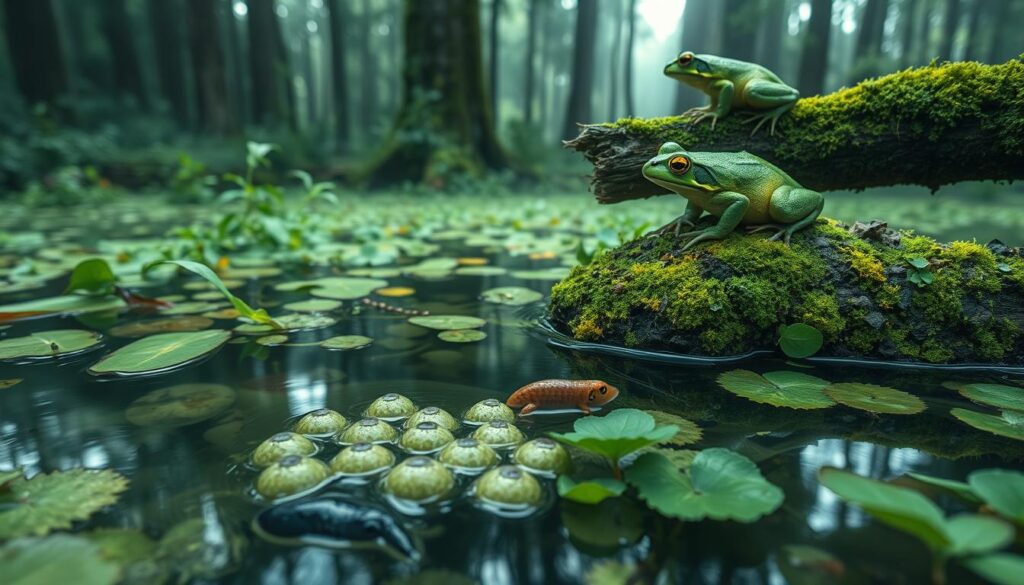
One of the most significant benefits of frogs is their role in pest control. Tadpoles feed on mosquito larvae, reducing the population of these disease-carrying insects. Adult frogs also consume large quantities of insects, helping to keep pest numbers in check naturally.
Frogs contribute to nutrient cycling by breaking down organic matter and recycling nutrients back into the pond or wetland. This process supports the growth of plants and other aquatic organisms, maintaining a healthy balance in the ecosystem.
“Frogs are bioindicators of environmental health, making them invaluable for scientific research and conservation efforts.”
Their observable life cycles make frogs an excellent subject for science education. For kids, studying frogs can spark curiosity about biology and environmental stewardship. Activities like monitoring frog populations or creating backyard ponds can engage communities in conservation efforts.
Frogs also have medical research applications. Their skin produces compounds that have potential uses in pharmaceuticals, including painkillers and antibiotics. Protecting their habitats ensures these resources remain available for future discoveries.
Wetland conservation is critical for frog survival. By preserving these habitats, we support not only frogs but also the countless species that depend on healthy wetlands. Initiatives like decline monitoring programs and citizen science projects can help track frog populations and promote habitat protection.
Creating backyard ponds is a simple yet effective way to support frog populations. These small habitats can provide safe spaces for frogs to breed and thrive, contributing to biodiversity. For more insights into frog eggs and their role in ecosystems, visit this detailed resource.
Conclusion
Understanding the stages of frog development offers a window into nature’s wonders. From eggs to adults, each phase highlights the beauty of transformation. Hands-on learning can make this process even more engaging. Consider using a frog kit to observe these changes at home or in a classroom setting.
Nature journaling is another excellent way to document observations. Encourage kids to sketch, write, and photograph their findings. This not only enhances learning but also fosters a deeper connection to the environment.
Promoting eco-friendly practices is crucial. Avoid collecting frogs from the wild; instead, support conservation efforts. Creating a small pond or wetland in your backyard can provide a safe habitat for these amphibians. For more tips on handling frogs responsibly, check out this guide.
By exploring the activities and resources available, we can all play a part in protecting these fascinating creatures. Let’s work together to ensure frogs continue to thrive in our ecosystems.
FAQ
Where do frogs lay their eggs?
How many eggs do frogs lay?
What does a tadpole look like?
What do tadpoles eat?
When do tadpoles develop legs?
How do tadpoles with legs behave?
What is a froglet?
How do froglets transition to land?
What does an adult frog look like?
What do adult frogs eat?
Why is the life cycle of frogs important?

I’m Lena Adams—a product of an unconventional upbringing in the African wilderness. My father, a daring explorer of African wildlife, sparked my fascination with reptiles, a passion that intertwined with the tragic loss of my mother during an expedition, leaving an indelible mark on my life. Driven to understand the creatures that captivated my parents, I embarked on my journey, sharing insights about reptiles, frogs, and lizards on my website. Through my explorations and conservation efforts, I honour my family’s legacy while seeking connections—to the creatures, nature, and the mother whose presence I yearn to understand.
